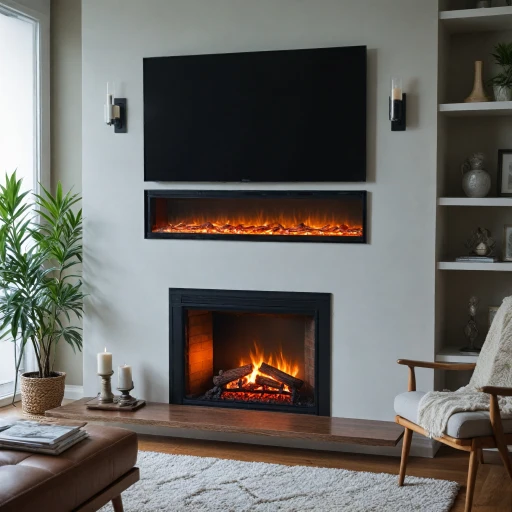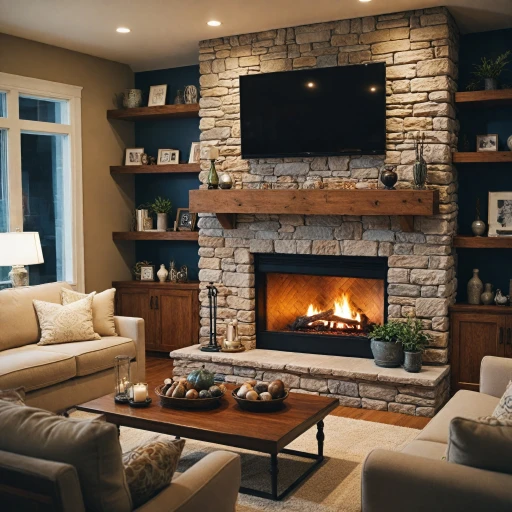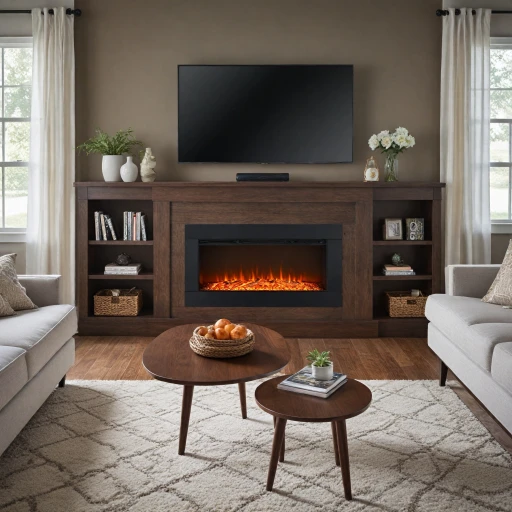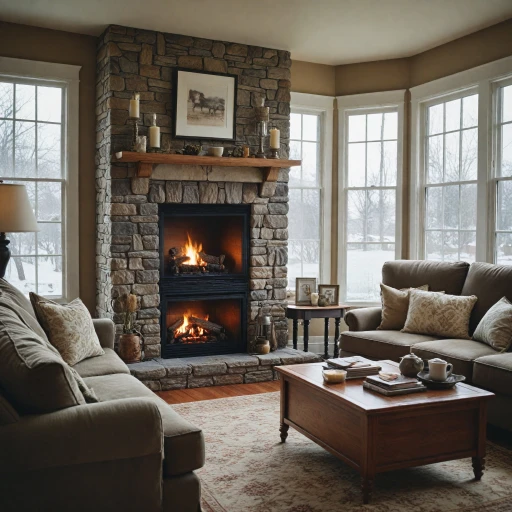
Comparing Gas and Electric Fireplaces
Spotlighting Differences
When it comes to warming up your home, you're probably considering both gas and electric fireplaces as potential options. Let's break down how these two choices stack up against each other.- Initial Setup and Costs: Gas fireplaces generally require more rigorous installation compared to their electric counterparts. The need for a vent or chimney, especially for vented gas models, can drive up labor and material costs. Electric fireplaces, meanwhile, bypass this hassle entirely, often leading to less complex and costly setups.
- Efficiency: While natural gas fireplaces offer robust heat output, electric units have been making waves for their energy efficiency and ease of use. They operate by converting electricity directly into heat rather than burning gas or wood. Some people even enhance the efficiency of a gas fireplace by using a wood stove fan to circulate heat more effectively.
- Design Versatility: Electric fireplaces provide incredible design flexibility. They can be installed in almost any space without structural changes like adding a chimney or vent. Gas units usually require more planning to incorporate into your home.
- Environmental Considerations: Electric fireplaces also win points for being a cleaner option for the environment. They don’t emit smoke or carbon monoxide, unlike gas and wood-burning options.
Initial Costs of Adding a Gas Fireplace
Breaking Down the Initial Costs of Gas Fireplace Installation
When considering a gas fireplace, it's essential to understand the initial expenses involved in the installation process. Unlike electric fireplaces, which are often simpler to set up, gas fireplaces require more extensive preparation and resources. Here's a closer look at what you might expect:
- Fireplace Unit: The cost of the gas fireplace unit itself can vary widely, depending on the model and features you choose. Basic models might be more affordable, but high-end units with advanced features will increase your budget.
- Installation Costs: Installing a gas fireplace is not a DIY project. It requires professional installation, which includes labor costs. The complexity of the installation, such as whether you need a new chimney or venting system, can significantly affect the total cost.
- Venting and Chimney: A vented gas fireplace needs a proper venting system to safely expel gases. If your home doesn't already have a suitable chimney or vent, you'll need to factor in the cost of installing one.
- Gas Line Installation: Connecting your fireplace to a natural gas line is another necessary step. This often requires a licensed professional, adding to the overall expense.
- Fireplace Inserts: If you're converting an existing wood-burning fireplace to gas, a fireplace insert might be necessary. This can simplify the process but will add to the initial costs.
These initial expenses can add up, making it crucial to plan your budget carefully. For a more detailed understanding of the components involved in a gas fireplace, you can explore this guide.
Long-term Costs and Maintenance
Evaluating Continuing Expenses and Upkeep with Gas Fireplaces
When considering a gas fireplace, it's important to factor in not just the initial cost to install gas, but the expenses that come with its day-to-day operation and upkeep. Gas fireplaces, commonly fueled by natural gas, are known for their efficiency and convenience, yet they come with their own set of ongoing costs and maintenance requirements. Operating a gas fireplace entails costs primarily related to the consumption of natural gas. This can vary depending on how often the fireplace is used and local gas prices. On average, using a gas fireplace can add a modest amount to your monthly utility bill, but many homeowners find this a reasonable price for the comfort and ambiance. Beyond gas consumption, regular maintenance is key to keeping your gas fireplace in good working order. Professional servicing annually is advisable to ensure the unit burns efficiently and safely. This usually involves cleaning the burner, and checking parts like the pilot light and gas logs, which, if neglected, can lead to issues or decreased efficiency over time. Additionally, consider the costs associated with vented systems. A direct vent or vented gas fireplace, which necessitates a chimney or special venting, might require inspection or cleaning to ensure it's free of blockages and functioning properly. While a vent-free unit may skip this need, it can come with its own considerations regarding air quality. Ultimately, gas fireplaces can save on labor and mess compared to wood burning options, with no need to haul wood or clean ash. While not free from costs, understanding these financial aspects brings peace of mind and prepares you for making an informed choice for your home. For more insights into different fireplaces, visit this page to learn about the expenses related to installing an electric fireplace. This comparison can help weigh the pros and cons tailored to your preferences and home heating needs.Benefits of Electric Fireplaces
Why Electric Fireplaces Are a Smart Choice
Deciding on a fireplace is no easy task, but electric fireplaces come with a bunch of advantages that make them a compelling choice compared to their gas or wood-burning counterparts. Here's why they may win you over:
- Easy Installation: An electric fireplace keeps things simple. No need for intricate vents or costly chimney setups often associated with wood or gas. You can typically just plug an electric unit into any standard outlet.
- Low Maintenance: Forget cleaning out ashes or worrying about gas leaks. Electric fireplaces are hassle-free, letting you relax and enjoy the warmth with minimal upkeep.
- Cost Efficiency: Initial costs can be lower than gas fireplaces not only due to simpler installation but also because they don’t require replacements of parts like flues or special vents. Plus, they're energy-efficient, helping you save on electricity bills.
- Adaptability: From compact inserts to stylish fireplace units, there's something for every room, adapting easily to different aesthetics and spatial needs.
- Safety First: No open flame means a lower risk of accidents. They're cooler to the touch, making them a safer option for homes with kids or pets.
For those prioritizing convenience, low upfront costs, and safety, electric fireplaces certainly shine. The choice depends on what best fits your home's needs and lifestyle preferences.
Cost Considerations for Electric Fireplaces
Evaluating the Financial Aspects
Electric fireplaces have gained popularity as a cost-effective alternative to traditional gas units. Let’s break down the financial side of things:- Initial Investment: Electric fireplaces often have a lower purchase price than gas. You won’t need to worry about a complex installation process, chimney, or venting systems, potentially saving on hefty labor costs. They’re generally plug-and-play, so what you see is what you get.
- Running Costs: They offer a noticeable advantage when it comes to energy consumption. These units typically utilize less power compared to gas options that consume natural gas. Plus, the heat output can be adjusted, letting you balance warmth with efficiency.
- Maintenance Expenditure: You’ll find that electric fireplaces are low maintenance. Forget the ash cleanup associated with wood-burning models or the regular chimney sweeping and vent inspection for their gas counterparts.
Making the Right Choice for Your Home
Choosing the Best Fireplace for Your Needs
When it comes to deciding between a gas and an electric fireplace, several factors come into play. Each type has its own set of benefits and costs, which can influence your decision based on your specific needs and circumstances.
Consider Your Budget
Initial and long-term costs are crucial considerations. Gas fireplaces often involve higher installation costs due to the need for venting and potential modifications to your home, such as installing a chimney or direct vent system. On the other hand, electric fireplaces typically have lower upfront costs and are easier to install, often requiring just a standard electrical outlet.
Think About Maintenance
Maintenance is another key factor. Gas fireplaces require regular inspections and cleaning to ensure safe operation, especially if you opt for vented gas logs or inserts. Electric fireplaces, however, are generally low-maintenance, with no need for chimney cleaning or gas line inspections.
Evaluate Heat Output and Efficiency
If heat output is a priority, consider how each type performs. Gas fireplaces provide a robust heat source, ideal for larger spaces or colder climates. Electric units, while efficient, may not offer the same level of warmth but are perfect for supplemental heating.
Assess Aesthetic Preferences
Your personal style and home decor can also influence your choice. Gas fireplaces offer a more traditional look with real flames, while electric models provide versatility with various designs and flame effects.
Environmental Impact
For those concerned about environmental impact, electric fireplaces are often seen as a greener option. They don't produce emissions and can be powered by renewable energy sources, unlike their gas-burning counterparts.
Ultimately, the right choice depends on balancing these factors with your personal preferences and lifestyle. Whether you prioritize cost, maintenance, heat, or aesthetics, understanding these elements will help you make an informed decision that suits your home and needs.












